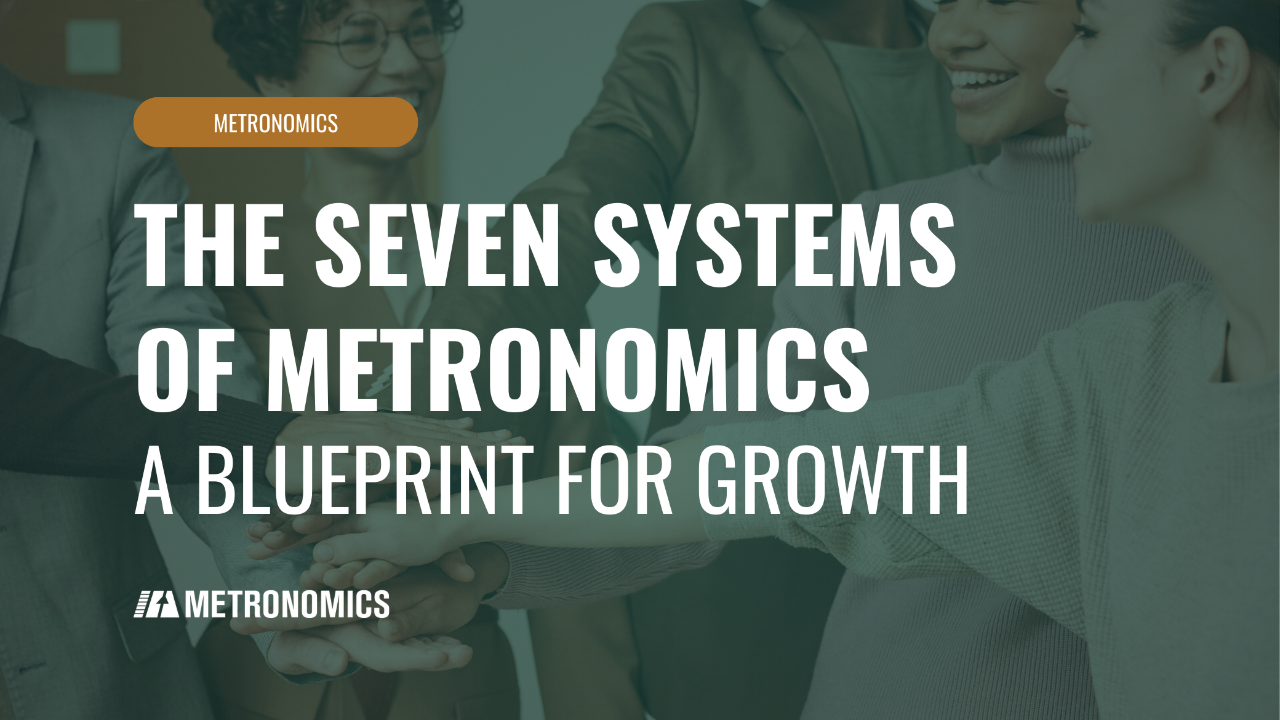The Seven Systems of Metronomics: A Blueprint for Business Growth

Many leaders and teams we come across are eager to understand the core components that drive the Metronomics framework. Whether they’ve just finished our book ‘Metronomics’ or are midway through their journey with a Metronomics coach, the question often arises: "How many systems are there?"
The answer is simple: Seven.
Metronomics is designed as a repeatable, structured, and prescriptive process. By applying it consistently, businesses can achieve predictable results. The framework is structured to make sense and is designed to be applied progressively over time. We call this the “Compound Growth System”—a method that, when applied methodically, fosters growth year after year.
Hear what one Metronomics client had to say about their journey:
“I promote Metronomics all the time and tell everyone they should do it. I was just on a tech-based speed dating style call with ten start-up companies, and I told every single one of them you need read The Metronome Effect, the 3HAG Way and Metronomics. Read all three and do exactly what they tell you to do… and you will be successful.” - Beanworks Solutions, Inc.
The Metronomics “House” Model
Imagine the Metronomics framework as a house, with a foundation and walls representing the systems that uphold the structure. This model has evolved to include the seven systems, divided into two categories: Soft Edge Systems and Hard Edge systems.
The Soft-Edge Systems include:
- The Cultural System
- The Cohesive System
- The Human System
The Hard-Edge Systems include:
- The Strategic System
- The Execution System
- The Cash System
The Soft-Edge Systems focus on people and culture, while the Hard-Edge Systems are about strategic execution and financial planning.
Soft Edge Systems: Building the Right Foundations
- The Cultural System
This system ensures clarity and alignment in your company culture. It establishes a shared vision, core values, and long-term goals, such as the Big Hairy Audacious Goal (BHAG). The CEO plays a crucial role in communicating and embodying this culture. - The Cohesive System
The Cohesive System, influenced by Patrick Lencioni’s ‘The Five Dysfunctions of a Team’, focuses on building trust, managing conflict, and fostering commitment and accountability within the team. It ensures that the soft edge systems are working together harmoniously, creating a structured approach to achieving sustainable success and growth. - The Human System
As Jim Collins famously said, "First Who, Then What.". Success begins with a strong leadership team. Having a team of A-Players is crucial. The Human System, inspired by Brad Smart’s Topgrading approach and his new book "Foolproof," emphasizes clear role expectations and accountability. This ensures that your team is not only highly skilled but also aligned with your company’s culture and strategic goals.
Hard Edge Systems: Navigating Strategy, Execution, and Cash
- The Strategic System
Effective strategy sets a business apart. Drawing on Michael Porter’s competitive strategy concepts, the Strategic System focuses on creating a unique market position through deliberate choices. This system helps translate complex strategies into simple, actionable plans for the entire team. - The Execution System
Execution translates strategy into daily actions. This system involves setting annual and quarterly goals, establishing clear accountabilities, and maintaining communication rhythms to ensure alignment and progress toward business objectives. - The Cash System
Managing cash flow is critical for growth. The Cash System emphasizes forecasting and monitoring cash flow, integrating financial and non-financial metrics to manage performance and respond to market changes effectively.
The Seventh System: Coach Cascade
At the heart of the Metronomics framework is the Coach Cascade System. This system, situated at the base of the “house”, focuses on developing leaders into coaches who can guide their teams toward high performance. This process involves nurturing Level 5 Leaders who lead with humility and will, often with the support of an external coach to uncover and address blind spots.
Conclusion
Understanding the Seven Systems of Metronomics provides a comprehensive blueprint for business growth. These systems form the foundation of a repeatable, structured process designed to deliver predictable results and foster continuous improvement. From the foundational Soft-Edge Systems—The Cultural System, The Cohesive System, and The Human System—to the strategic Hard-Edge Systems—The Strategic System, The Execution System, and The Cash System—each component plays a crucial role in building a robust organizational framework.
Discover the growth framework that helped multiple companies sell for millions.
Join Shannon Byrne Susko and Ged Roberts as they discuss balancing hard-edge strategy with the "human element" for sustainable success. Tune in to the Tip Top - Grow Up Your Business with Metronomics podcast today!
